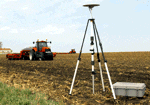
In the paper ‘Precision agriculture: challenges and opportunities in a flat world’ by author
R. Khosl, the principles of precision agriculture are discussed. The author states, ” in precision nutrient
management, “Right manner”, refers to the method of placement of nutrient in the soil, (i.e.) broadcast
versus banding, dribbling, injecting, etc. The “right manner” aspect may be not be very important for
agriculture practiced in the developed world, however, it is of great importance for global precision
agricultural practices.” Accordingly, many of the readers of this publication (oriented toward Asia), are directly impacted by the three “R”s.
The connection between geospatial data and farm production requires a link between the spatial data tools and technologies and the agronomic principles necessary for achieving maximum agronomic gains.
However, to ensure the right products are placed at the right place at the right time, does not necessarily mean advanced technologies must be used. With adequate manual labor available, precision famring may take place – albeit with less consistency, probably more time consuming and possibly at inappropriate times. Nevertheless, before agronomic inputs can be applied, sound geospatial data about the landscape, an understanding of soil management principles and available meteorological information all contribute toward increased chances of success.
The geospatial tools and technologies that are used to gain information for food production are the same tools that are used for urban planning, disaster management and a host of other applications including telcoms, transport, highway construction etc.
Consequently, the motto ‘The Right time, the Right Amount and the Right Place’ applies across the board when it comes to geospatial tools and technologies. Remote sensing, airborne imagery, CAD, GIS, mapping and sensors are agile technologies and can be dispersed and applied to many applications. For Asia, the real value of this principle means that those countries using such tools for disaster alone, for example, ought to consider how to re-purpose and re-apply their geospatial inventory and resources to other capacities – from time to time.
While inefficiency in food production may take place under manual precision farming operations, re-purposed technologies hold the promise for incressing food production, creating economic value immediately and resulting in more mouths being fed. That alone is worth any attempt to capitalise upon existing resources with new approaches.